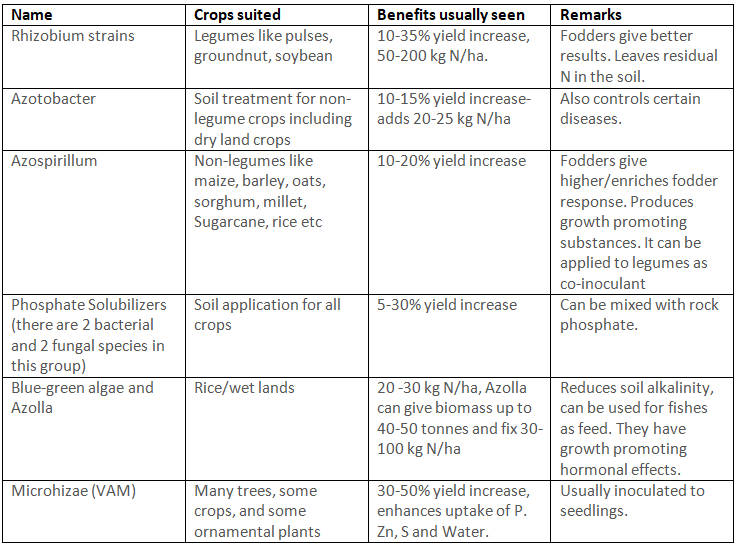Bio-fertilizers - 1 | Agriculture Optional for UPSC PDF Download
| Table of contents |

|
| About Biofertilizers |

|
| Benefits of Biofertilizers |

|
| Types and features of Biofertilizers |

|
| List of commonly produced bio-fertilizers in India |

|
| Biofertilizers recommended for crops |

|
About Biofertilizers
In nature, numerous beneficial soil microorganisms play a crucial role in aiding plants' nutrient absorption. Through human intervention, these microorganisms can be optimized by selecting the most efficient ones, cultivating them, and introducing them to soils either directly or through seeds. When these cultured microorganisms are packed into a carrier material for convenient field application, they are referred to as bio-fertilizers. Consequently, the key component of bio-fertilizers is the microorganisms themselves.
Benefits of Biofertilizers
Bio-fertilizers are composed of living microorganisms that originate from bacteria, fungi, and algae. Their modes of action vary and can be used individually or in combination.
- Nitrogen Fixation: Bio-fertilizers facilitate the fixation of atmospheric nitrogen in both the soil and the root nodules of leguminous crops, making it accessible to the plant.
- Phosphate Solubilization: They have the ability to convert insoluble forms of phosphates, such as tricalcium, iron, and aluminum phosphates, into forms that are readily available to plants.
- Phosphate Scavenging: Bio-fertilizers scavenge phosphate from different soil layers.
- Hormone and Anti-Metabolite Production: They produce hormones and anti-metabolites that stimulate root growth.
- Organic Matter Decomposition: These microorganisms play a role in breaking down organic matter and aiding mineralization in the soil.
- Nutrient Availability and Yield Increase: When applied to seeds or soil, bio-fertilizers enhance nutrient availability and can boost yields by 10 to 25% without negatively impacting the soil or the environment.
Types and features of Biofertilizers
Based on type of microorganism, the bio-fertilizer can also be classified as follows:
- Bacterial Biofertilizers: Examples include Rhizobium, Azospirilium, Azotobacter, and Phosphobacteria.
- Fungal Biofertilizers: Mycorhiza is an example.
- Algal Biofertilizers: Blue Green Algae (BGA) and Azolla fall into this category.
- Actinomycetes Biofertilizer: Frankia is an instance of this type.
Bio-fertilizers are primarily produced and multiplied in laboratory settings. However, blue green algae and azolla can be mass-produced in the field.
Characteristics Features of common Biofertilizers
- Rhizobium: Rhizobium is a widely used and highly effective biofertilizer. It forms a symbiotic relationship with legumes, enabling them to fix atmospheric nitrogen by creating root nodules. Successful nodulation depends on finding a compatible Rhizobium strain for a specific legume. The presence of leguminous crops in the field influences the population of Rhizobium in the soil; it diminishes in the absence of legumes.
- Azospirillum: Azospirillum has a close symbiotic association with various higher plants. These bacteria are linked with cereals such as sorghum, maize, pearl millet, finger millet, foxtail millet, and other minor millets, as well as with fodder grasses.
- Azotobacter: Azotobacter is a common soil bacterium, with A. chrococcum widely distributed in Indian soil. Soil organic matter plays a vital role in regulating the growth of these bacteria.
- Blue Green Algae (BGA): Blue green algae are often found in rice fields and are sometimes referred to as rice organisms. Numerous species from genera like Tolypothrix, Nostic, Schizothrix, Calothrix, Anoboenosois, and Plectonema are abundant in tropical regions. Most nitrogen-fixing BGA are filamentous, composed of chains of vegetative cells, including specialized cells called heterocysts that serve as microsites for nitrogen synthesis and fixation machinery.
List of commonly produced bio-fertilizers in India

Biofertilizers recommended for crops
- Rhizobium + Phosphotika for Pulses: To enhance the growth of pulses like pigeonpea, green gram, black gram, cowpea, groundnut, and soybean, it is recommended to treat 10 kg of seeds with a mixture of 200 grams each of Rhizobium and Phosphotika.
- Azotobacter + Phosphotika for Cereals and More: For crops like wheat, sorghum, maize, cotton, and mustard, you can improve their development by treating 10 kg of seeds with a combination of 200 grams each of Azotobacter and Phosphotika.
- Transplanted Rice Enhancement: When it comes to transplanted rice, it is advised to immerse the seedling roots in a solution containing 5 kg each of Azospirillum and Phosphotika per hectare for a duration of 8 to 10 hours.
|
52 videos|224 docs
|
FAQs on Bio-fertilizers - 1 - Agriculture Optional for UPSC
| 1. What are biofertilizers and what are their benefits? |  |
| 2. What are the types of biofertilizers and their features? |  |
| 3. What are some commonly produced biofertilizers in India? |  |
| 4. Which biofertilizers are recommended for specific crops? |  |
| 5. How do biofertilizers contribute to sustainable agriculture? |  |















